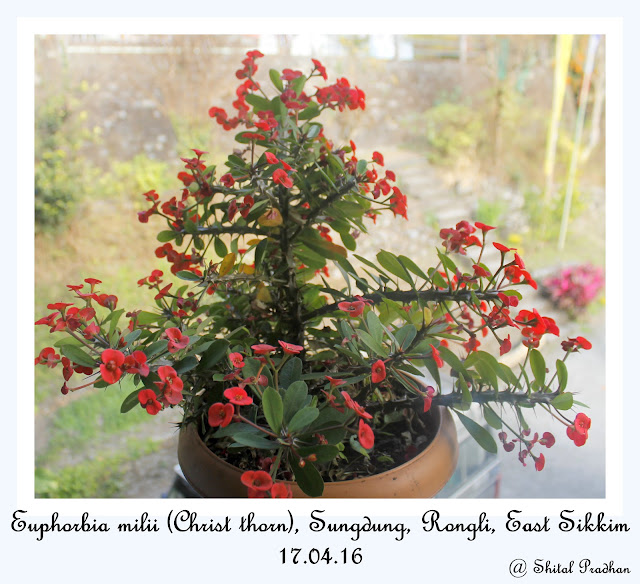Monday, 8 April 2019
Hebomoia glaucippe (Great Orange Tip) - Sikkim Butterfly
Tuesday, 16 February 2016
Blue-fronted redstart (Phoenicurus frontalis - female) - Sikkim Bird
Monday, 15 February 2016
Yellow-bellied fantail (Chelidorhynx hypoxantha) - Sikkim Bird
Friday, 8 January 2016
Euphorbia pulcherrima (Poinsettia) - Sikkim Flora
Sunday, 3 January 2016
Garrulax ocellatus (Spotted laughingthrush) - Sikkim Bird
Monday, 9 June 2014
Euphorbia milii (Euphorbia) - Sikkim Flora

Genus: Euphorbia
The sap is moderately poisonous, and causes irritation on contact with skin or eyes. If ingested, it causes severe stomach pain, irritation of the throat and mouth, and vomiting. (Source: Wikipedia)
Thursday, 3 April 2014
Monticola solitarius (Blue Rock Thrush) - Sikkim Bird
 | |
Monticola solitarius (Blue Rock Thrush - female)
Place : Sirwani, East SikkimDate: February 16, 2010 Pic: Krishna Dahal |
| Kingdom: | Animalia |
| Phylum: | Chordata |
| Class: | Aves |
| Order: | Passeriformes |
| Family: | Muscicapidae |
| Genus: | Monticola |
| Species: | M. solitarius |
Friday, 21 March 2014
Buceros bicornis (Great Pied Hornbill) - Sikkim Bird
 |
Buceros bicornis (Great Pied Hornbill)
Other name: Great Hornbill, Great Indian Hornbill
Venue: Singtam, East Sikkim
Date: February 4, 2014
Pic: Krishna Dahal
|
 |
Buceros bicornis (Great Pied Hornbill)
Other name: Great Hornbill, Great Indian Hornbill
Venue: Shantinagar, Singtam, East Sikkim
Date: June 8 2014
Pic: Shital Pradhan
|
| Kingdom: | Animalia |
| Phylum: | Chordata |
| Class: | Aves |
| Order: | Coraciiformes |
| Family: | Bucerotidae |
| Subfamily: | Bucerotinae |
| Genus: | Buceros |
| Species: | B. bicornis |
Monday, 10 February 2014
Pycnonotus leucogenys (Himalayan Bulbul) - Sikim Brd
 |
Pycnonotus leucogenys (Himalayan Bulbul)
Venue: Sungdung, Rongli, East Sikkim
Date: January 6, 2014
Pic: Swarup Rai
|
The Himalayan Bulbul (Pycnonotus leucogenys), also called the White-cheeked Bulbul or Himalayan Bulbul, is a small bird from the Pycnonotidae family. It belongs to the Passeriformes order (perching birds) and is part of the Pycnonotus genus.
Found in the Himalayan
mountains across India, Nepal, Pakistan, Bhutan, and Afghanistan, this bird
enjoys forests, gardens, and hillsides, where its chirping adds a musical note
to the mountain air.
This bird is around 18 cm long and is known for its striking appearance. It features a black face and throat with a white cheek spot and a yellow vent. Its most distinctive feature is a mohawk-like crest on its head, setting it apart from other birds.
Its white-tipped tail fans out
beautifully as it flies. Often found in small groups, these active birds hop around,
chirping cheerfully to one another.
Besides its beauty, the
Himalayan Bulbul is helpful to the environment. It eats insects and fruits and helps to keep nature in balance. This little bird truly brightens its
mountain home!











